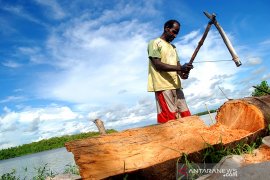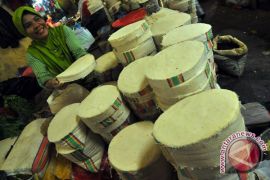An Asmat woodcarver can complete a carving in no time. No two woodcarvings created by them will be the same, and the paintings they do after the carving is complete actually accentuates the beauty of their art.
Woodcarving is not the sole ingenuity that the Asmat people have.
Asmat children spend their time swimming in the water along with their peers. With their formidable physical form, they can swim far in the swamp close to where they live.
Their endurance in the water means they can hunt shrimp and fish with ease despite the muddy water, thorny tree roots, and venomous snakes lurking in the swamp.
The Asmat people are able to track every step of the animals they hunt in the swamp. They do not take long to catch large shrimps with their bare hands and place their catch in a large basket.
“These shrimps need great effort to gather because we usually need to lift the pandanus tree root that might slash our skin. Hence, we swim only to hunt food,” Moses Foid, a resident of Damen Village, Asmat District, Papua, stated.
Their strong physique and endurance in water also helps the Asmat people to be good rowers. The row they use is made of strong wood planks with a sharpened tip at the end of the row handle that they use to shield themselves from beasts, such as crocodiles, that might approach them.
“Crocodiles here are huge. A resident of a neighboring village was eaten by the crocodile. We have no idea where they came from, but (a specimen of the crocodile) had been preserved at a local museum,” a state employee in Damen Village, Petrus Fumori, stated.
Asmat villagers sometimes stalk crocodiles to search and crush eggs laid by them in the forest, which may reach 200-300 in one season, Fumori remarked.
Gathering resources from forests
The Asmat people do not solely rely on resources existing in their village for their living. Living in peatlands with no dry roads, they often head to forests on foot to gather resources, with sago being among the most sought after, the state employee stated.
Regina Taobire, aged 17, loves her duty as a gatherer for her community. She said they could wander far inside the forest to search for the best sago tree.
In their journey to gather sago, Taobire said they would bring equipment, such as an axe, pickaxe-like sago pounder, wicker tray, and traditional woven bag called noken – a UNESCO intangible cultural heritage.
After arriving in the forest, the adults, who lead the group, will determine which tree must be cut. They will then cut the sago tree exactly in the middle. In case the tree trunk is weak, they will first pick a hole in the tree's centre to ease its falling.
After the tree is cut, they will peel the bark from the tree, and with a pickaxe, cut any small branches in the trunk. Once clean, the adults will start pounding the white part of the trunk to make a sago pulp. A sago tree trunk can produce at least 20 to 30 kilograms of sago, Taobire stated.
The next process is to clean the pounded white pulp of the sago tree by soaking and squeezing the pulp in the water thrice until the pulp comes out. The pulp will be placed in noken bags, which children in the group will carry home.
She said that sometimes it took more than a day to finish pounding the tree trunk. If all members of the groups are tired, they will bring home the day’s pulp and leave the unfinished trunk for tomorrow.
“We do not bring all of it home. Sometimes, we let the trunk sit for three weeks for the sago maggots to appear. (The maggot) tastes good if we mix and cook it with the sago. My mother likes to make it. She will first roast the sago before consuming it; the sago will harden by itself, and we eat without condiments,” Taobire expounded.
Hendrika, Taobire’s peer, said they often join their parents to gather sago from morning until midday, and their mother prefers combining sago with fish or other vegetables.
Apart from sago, the Asmat people also gather agarwood, a tree with a distinctive fragrance used for incense and perfumes in industries. The Asmat people often obtained a contract from Surabaya or Jakarta to get the agarwood, for which work may take six months to a year to complete.
Erduadus Tinik, aged 39, stated that the Asmat community would set up a team of 20 people before starting their journey to gather agarwood. Gathering agarwood needs several people to chip in, as they need to dig a lot of trees to look for good-quality agarwood, he said.
They also need to travel far from the village, as most agarwood trees grow in the river upstream area and in the depths of Papua's forests, he added.
“If we found a lot of good trees, it will be a fortune for us. I had got varied incomes of Rp5 million (US$335), Rp10 million (US$670), and Rp15 million (US$1,005) in some of my past journey (for agarwood),” Tinik revealed.
Not all parts of the agarwood tree will be harvested, he noted, adding that they will only obtain the black part of the tree trunk, which is profitable, and discard the white part.
Unfortunately, despite the million rupiah in profits, the Asmat people barely enjoy profits from agarwood harvesting. They often need to repay their debt for their journey expenses and purchase new equipment from the dealer before spending the rest of the income on their own.
“I had once earned Rp27 million (US$1,809) as profit (from gathering agarwood), but it is not much, I say. I need to also pay for my child’s schools,” Regina’s father, Yanuarius Wauman, aged 35, stated.
The Asmat people, with their ingenuities, can live in an environment that others may see as harsh and utilize resources from the hostile forest for their living. The Asmat people, not hindered by swamps and muddy forests in upgrading their lives, are an example of persistence that must be emulated by others.
Related news: Social Affairs Ministry builds 10 chicken farms in Asmat, Papua
Related news: Wings Air serves Timika-Asmat-Merauke flights from Aug 10
Editor: Rahmad Nasution
Copyright © ANTARA 2022












